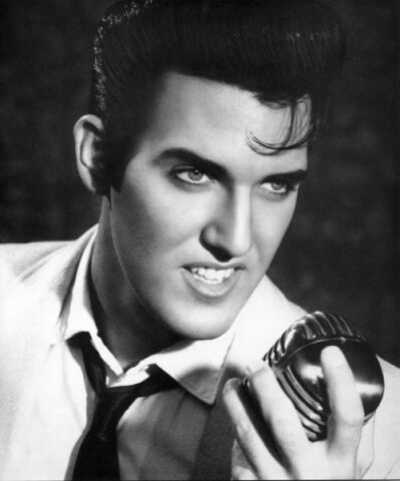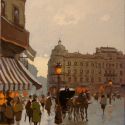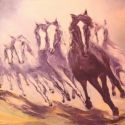
photo:
https://www.topnews.in/files/Elvis-Presley-696.jpg
Biography
An American phenomenon
According to Rolling Stone magazine "It was Elvis who made rock 'n' roll the international language of pop." A PBS documentary once described Presley as "an American music giant of the 20th century who singlehandedly changed the course of music and culture in the mid-1950s." [2]. His recordings, dance moves, attitude and clothing came to be seen as embodiments of rock and roll. His music was heavily influenced by African-Americans who could not gain national attention because of their race. Presley sang both hard driving rockabilly and rock and roll dance songs and ballads, laying a commercial foundation upon which other rock and roll musicians would build. African-American performers like Little Richard and Chuck Berry came to national prominence after Presley's acceptance among mass audiences of white teenagers, even though his music was strongly influenced by some of those same African-American musicians. Singers like Jerry Lee Lewis, the Everly Brothers, Buddy Holly, Roy Orbison and others immediately followed in his wake, leading John Lennon to observe later, "Before Elvis, there was nothing."
Elvis Presley at the Mississippi-Alabama State Fair, 1956
Teenagers came to Presley's concerts in unprecedented numbers. When he performed at the Mississippi-Alabama Fair in 1956 a hundred National Guardsmen surrounded the stage to control crowds of excited fans. When municipal politicians began denying permits for Presley appearances teens piled into cars and traveled elsewhere to see him perform. It seemed as if the more adults tried to stop it, the more teenagers across North America insisted on having what they wanted. When adult programmers announced they would not play Presley's music on their radio stations (some because God told them it was sexually suggestive Devil music, others saying it was Southern "nigger" music) the economic power of that generation became evident when they tuned in any radio station playing Elvis records. In an industry already shifting to all-music formats in reaction to television, profit-conscious radio station owners learned hard lessons when sponsors bought advertising time on new rock and roll stations reaching enormous markets at night with clear channel signals from AM broadcasts.
During the 1950s post-WWII economic boom in the United States, many parents were able to give their teenaged children much higher weekly allowances, signalling a shift in the buying power and purchasing habits of teens. During the 1940s bobby soxers had idolized Frank Sinatra but the buyers of his records were mostly between the ages of eighteen and twenty-two. Presley triggered a juggernaut of demand for his records by near-teens and early teens aged ten and up.
Presley's overwhelming appeal was to girls. Many boys adopted his look to attract them. Along with Elvis' ducktail haircut, the demand for black slacks and loose, open-necked shirts resulted in new lines of clothing for teenaged boys. In 1956 America, birthday and Christmas gifts were often music or even Elvis related. A girl might get a pink portable 45 rpm record player for her bedroom. Meanwhile American teenagers began buying newly available portable transistor radios [3] and listened to rock 'n' roll on them (helping to propel that fledgling industry from an estimated 100,000 units sold in 1955 to 5,000,000 units by the end of 1958). Teens were asserting more independence and Elvis Presley became a national symbol of their parents' consternation.
Presley's impact on the American youth consumer market was noted on the front page of The Wall Street Journal on December 31, 1956 when future Pulitzer Prize-winning business journalist Louis M. Kohlmeier wrote, "Elvis Presley today is a business," and reported on the singer's record and merchandise sales (this may have been the first time a journalist described an entertainer as a business). Half a century later, historian Ian Brailsford (University of Auckland, New Zealand) commented, "The phenomenal success of Elvis Presley in 1956 convinced many doubters of the financial opportunities existing in the youth market." [4]
Birth and childhood
Elvis Aron Presley was born in a two-room house in East Tupelo, Mississippi to Vernon Elvis Presley and Gladys Love Smith. His twin brother, Jesse Garon, was stillborn, thus leaving him to grow up as an only child. Elvis was given the middle name of Aron, with only one A, so he would always be a part of his brother Jesse Garon. The surname Presley was Anglicized from the German Pressler during the Civil War. His ancestor Johann Valentin Pressler emigrated to North America in 1710. Pressler first settled in New York, but later moved to the South. He was of mostly Scottish [5] and English descent; the family also has Native American, German, and South African.
Elvis Presley was raised both in East Tupelo and later in Memphis, Tennessee, where his family moved when he was 13. In 1949 the family moved to Lauderdale Courts public housing development which was near musical and cultural influences like Beale Street, Ellis Auditorium and the Popular Tunes record store along with the Sun Studio about a mile away.
Elvis took up the guitar and practiced in the basement laundry room at Lauderdale Courts. He played gigs in the malls and courtyards of the Courts with other musicians who lived there. After high school he worked at Precision Tool Company, then drove a truck for the Crown Electric Company.
The Sun recordings
Main article: Elvis Presley's Sun recordings
In the summer of 1953, Presley paid $4 to record the first of two double-sided demo acetates at Sun Studios, "My Happiness" and "That's When Your Heartaches Begin" which were popular ballads at the time. According to the official Presley website, Elvis reportedly gave it to his mother as a much-belated birthday present. Sun Records founder Sam Phillips and assistant Marion Keisker heard the discs and called him in June 1954 to fill in for a missing ballad singer. Although that session was not productive, Sam Phillips put Elvis together with local musicians Scotty Moore and Bill Black to see what might develop. During a rehearsal break on July 5, 1954, Elvis began singing a blues song written by Arthur Crudup called "That's All Right". Phillips liked the resulting record and released it as a 78RPM single backed with Elvis' hopped-up version of Bill Monroe's bluegrass song "Blue Moon Of Kentucky." Memphis radio station WHBQ began airing it two days later, the record became a local hit and Elvis began a regular touring schedule which expanded his fame beyond Tennessee.
Country music star Hank Snow arranged to have Presley perform at Nashville's Grand Ole Opry and his performance was received well by the audience. Nonetheless, one of the show's executives was far from impressed and hinted that Presley should give up his music. However, since that time many singers (Garth Brooks among them) have commented that one of the greatest thrills of playing the Opry is that they played on the same stage as Presley.
He continued to tour the U.S. South. On October 16, 1954, he made his first appearance on Louisiana Hayride, a radio broadcast of live country music in Shreveport, Louisiana and was a hit with the large audience. Following this, Presley was signed to a one-year contract for a weekly performance during which time he was introduced to Colonel Tom Parker. This helped sales of his records as his releases began to reach the top of the country charts.
The management of Colonel Tom Parker
On August 15, 1955 Elvis Presley was signed by "Hank Snow Attractions", a management company jointly owned by singer Hank Snow and Colonel Tom Parker. Shortly thereafter, Colonel Parker took full control and, recognizing the limitations of Sun Studios, negotiated a deal with RCA Records on November 21, 1955, then immediately established two New York City recording companies for Presley's music. Understanding the commercial value for any composer having their song recorded by Presley, Parker was able to demand they share their royalties with the singer. A master promoter who wasted no time in marketing Presley's image, Parker licensed everything from guitars to cookware. After being approached by the Hollywood Studios, Parker eventually negotiated a multi-picture seven-year contract that shifted Presley's focus from music to films. Under the terms of his contract, Presley earned a fee for performing plus a percentage of the profits on the films, most of which were huge moneymakers. (See "Movies" section below.) With money seemingly being at the forefront of all decisions made by the Colonel, his success led to his management contract with Elvis being renegotiated to an even 50/50 split between the two. Over the years, much has been written about Colonel Parker, most of it critical. Marty Lacker, a lifelong friend and a member of the Memphis Mafia, says he thought of Parker as a "hustler and scam artist" who abused Elvis's reliance on him. Nonetheless, along with Lamar Fike, and Presley's first cousin Billy Smith, Lacker acknowledged that Parker was a master promoter as recounted in their 1995 book Elvis Aron Presley: Revelations from the Memphis Mafia. In the 2005 television special about her former husband, Priscilla Presley said she didn't know who else there was at the time in 1955 who could have seized the moment and done the job of marketing Elvis. Parker's definitive biography was written by award-winning journalist Alanna Nash published in 2003.
Military service
On December 20, 1957, Presley received his draft notice for 2-year service with the United States Army. On March 24, 1958, he was inducted into the Army at the Memphis Draft Board. Presley received no special treatment and was widely praised for not avoiding service or serving part time in easy domestic positions such as the Special Services. The media speculated on whether or not two years out of the limelight would damage to his career. During his service, Elvis met Walter Alden, who was a sergeant and in charge of public relations. Years later Elvis would date Alden's daughter, Ginger.
Presley sailed to Europe on the USS General George M. Randall (AP-115) and served in Germany, attaining the rank of sergeant. He returned to the United States on March 2, 1960 and was honorably discharged on March 5th. [6]
Comeback
Many observers (including John Lennon) later claimed that following Presley's return from military service the quality of his recorded output dropped, although others thought he was still capable of creating records equal to his best (and did so on the infrequent occasions where he was presented with "decent" material at his movie recording sessions). Presley himself became deeply dissatisfied with the direction his career would take over the ensuing seven years, notably the film contract with a demanding schedule that eliminated creative recording and giving public concerts. In 1960 the album Elvis is Back was recorded to mixed reviews by critics and fans. With this drop-off, and in the face of the social upheaval of the 1960s and the British Invasion spearheaded by The Beatles, Presley's star faded slightly before a triumphant televised performance later dubbed the '68 Comeback Special. Aired on the NBC network on December 3, 1968, the show saw him return to his rock and roll roots. His 1969 return to live performances, first in Las Vegas and then across the country, was noted for the constant stream of sold-out shows, with many setting attendance records in the venues where he performed throughout the country.
1969 onward
After seven years off the top of the charts, Presley's song "Suspicious Minds" hit No. 1 on the Billboard music charts on November 1, 1969. This was the last time any song by Presley hit #1 on the Hot 100, although "Burning Love" got as high as #2 in September 1972, and "A Little Less Conversation" topped the Hot Singles Sales chart in 2002. He still reached #1 on charts around the world. For example, "In The Ghetto" hit #1 in West Germany in 1969, and "The Wonder Of You" reached #1 in the UK in 1970. The "Aloha from Hawaii" concert in January 1973 was the first of its kind to be broadcast worldwide via satellite and his biggest audience ever. The soundtrack album was another #1 disc.
Way Down was racing up the American Country Music charts shortly before Presley's death in 1977, and hit #1 on that very chart the week he died (Presley recorded a number of country hits in his final years). It also topped the UK pop charts at the same time. Between 1969 and 1977 he gave over 1,000 sold-out performances in Las Vegas and on tour. He was the first artist to have four shows in a row sold to capacity at New York's Madison Square Garden. During the mid-1970s Presley became increasingly isolated, battling an addiction to prescription drugs and its resulting toll on his appearance, health and performances. Elvis Presley made his last live concert appearance in Indianapolis, Indiana at the Market Square Arena on June 26, 1977.
Movies
In late 1955, Presley made his earliest known film appearance in a documentary entitled The Pied Piper of Cleveland, a look at the career of disc jockey Bill Randle. The film, (which reportedly included performance footage of Elvis as well as Bill Haley and His Comets and other acts), was shown in its entirety only once (in Cleveland) and was never released commercially. The film is currently considered "misplaced" and some Presley researchers maintain it never existed, although there is ample evidence to suggest it did.
Beginning with Love Me Tender (opened on November 15, 1956), Presley starred in 31 motion pictures, having signed to multiple long-term contracts on the advice of his manager. These were usually musicals based around Presley performances, and marked the beginning of his transition from rebellious rock and roller to all-round family entertainer. Elvis was praised by all his directors, including the highly respected Michael Curtiz, as unfailingly polite and extremely hardworking.
The movies Jailhouse Rock (1957), King Creole (1958), and Flaming Star (1960) are widely regarded as his best among film critics. Among fans, Blue Hawaii (1961) and Viva Las Vegas (1964) are also highly praised.
In addition to his own films, Presley has been the subject of more than seventy films that have his name in the title.
For details on films in which he starred, see the List of Elvis Presley films.
Gospel roots
Ironically, for all the controversy surrounding his early career, Elvis Presley's roots in religious music ran deep. In Tupelo, Mississippi, Vernon and Gladys Presley were what was disparagingly referred to as poor white trash from the "wrong side of the tracks" at the east end of town. Their Depression-era home (where Elvis was born in 1935) was a two-room shack on one of several dirt tracks forming a small community off Old Saltillo Road. They belonged to a local Assembly of God Pentecostal church which played an important role in their lives. For Elvis Presley it provided an environment from which he would instinctively adopt the music, sound and accompanying body movements in his later rock and roll singing performances. The African American form of music that became known as Rhythm & Blues (which also evolved from gospel songs) was also a part of Presley's childhood world and he probably heard it on a regular basis in the black section of Tupelo known as "Shakerag" (which was between Tupelo and East Tupelo, and was demolished in the 1960s as part of an urban renewal project). The church is said to have brought the Presleys, along with the rest of its desperately poor congregation, a message of hope wrapped around "Hell, fire, and brimstone" sermons. For nearly a quarter century the Pentecostal movement was interracial and during the 1930s and 1940s many of these poor churches did not adopt the growing policy of racial segregation.
Although Vernon Presley's family was Pentecostal and his sister Nash Presley became a minister, his wife Gladys was Elvis's devoutly religious parent. Her uncle Gains Mansell was also a Pentecostal preacher in East Tupelo whose interracial church services began with revival meetings held in a tent. Pentecostal church services started, centered and ended with music and everyone was encouraged to "make a joyous noise unto the Lord." According to Presley biographer Peter Guralnick, Gladys Presley said that by the age of two her son was already trying to sing along in the church. A Pentecostal preacher would typically lead the congregation in prayer and both singing and prayer were accompanied by the waving of hands, the swaying of bodies and dancing about in the Holy Spirit. As it almost always did in those settings, "when the Spirit strikes" the body would jerk as though hit by a bolt of lightning and frequently the worshipper would fall to the floor, rolling around and praying aloud (this is why outsiders referred to church members as "Holy Rollers" and their services as a "religious frenzy"). For instrumentation, these church services used a guitar, a tambourine or two and if they could afford one, a well-worn piano and perhaps a used piano accordion. Church services lasting three hours and held several times a week were filled with music as Pentecostals gyrated their hips, shook their legs, clapped and waved their arms while belting out pounding, rhythmic songs such as Down By the Riverside, When The Saints Go Marching In and Standing On The Promises. There were also more serene songs sung with great emotion like The Old Rugged Cross and Softly and Tenderly (Jesus is calling).
In 1948 the Presley family left Tupelo, moving 110 miles northwest to Memphis, Tennessee. Here too, thirteen-year-old Elvis lived in the city's poorer section of town and attended a Pentecostal church. At this time, Presley was very much influenced by the Memphis blues.
While Elvis Presley was a teen cataclysm with millions of American girls screaming at the sight of him, his own church viewed Presley's gyrations on stage as an affront, labelling it the Devil's work and a mocking of the Baptism of the Holy Spirit. Presley records were condemned as wicked and Pentecostal preachers thumped their pulpits with Bibles, warning congregations to keep heathen rock and roll music out of their homes and away from their children's ears (especially the music of "that backslidden Pentecostal pup, Elvis Presley"). People who decades later would be considered part of the religious right spoke out vigorously against Presley including Cardinal Spellman. In its weekly periodical, the Roman Catholic Church added to the criticism in an article titled "Beware Elvis Presley."
In August, 1956 in Jacksonville, Florida a local Juvenile Court judge called Presley a "savage" and threatened to arrest him if he shook his body while performing at Jacksonville's Florida Theatre, justifying the restrictions by saying his music was undermining the youth of America. Throughout the performance Presley stood still as ordered but poked fun at the judge by wiggling a finger. Similar attempts to stop his "sinful gyrations" continued for more than a year and included his often noted January 6, 1957 appearance on The Ed Sullivan Show (during which he performed the spiritual number "Peace in the Valley") when he was seen only from the waist up.
His Hand In Mine (1960) was the title of Elvis' first gospel album. During his '68 Comeback Special Elvis said his music came from gospel. As heard in the 2005 televised special, Presley told a reporter that he "knew every gospel song there is." Despite his church's attitude, gospel music was a prominent part of Presley's repertoire throughout his life. From 1971 to his death in 1977 Presley employed the Stamps Quartet, a gospel group, for his backup vocals. He recorded several gospel albums, earning three Grammy Awards for his gospel music. In his later years Presley's live stage performances almost always included a rendition of "How Great Thou Art," the 19th century gospel song made famous by George Beverly Shea. More than forty-five years later (and twenty-four years after his death) the Gospel Music Association finally inducted him into their Gospel Music Hall of Fame (2001).
Well-Known Gospel Songs:
How Great Thou Art
He Touched Me
Peace In The Valley
He Is My Everything
Help Me
Why Me, Lord?
Amazing Grace
Swing Down Sweet Chariot
Voice characteristics
As noted by Henry Pleasants, in his book "The Great American Popular singers", Elvis Presley was a baritone whose voice had an extraordinary compass - the so-called register- and a very wide range of vocal color. The voice covered two octaves and a third, from the baritone low-G to the tenor high B, with an upward extension in falsetto to at least a D flat. Presley's best octave was in the middle, D-flat to D-flat. In ballads and country songs he was able to belt out full-voiced high G's and A's, showing a remarkable ability to naturally assimilate styles, and elliciting a multiplicity of voices.
Presley's range, albeit impressive in its own right, did not in itself make his voice that remarkable, at least in terms of how it measured against musical notation. What made it extraordinary, was where its center of gravity laid. By that measure, and according to Gregory Sandows, Music Professor at Columbia University, Elvis was all at once a bass, a baritone and a tenor, a most unique attribute amongst singers of any gender, both in the classical and popular music fields.
A more detailed account of Presley's vocal range, as noted by music analysts, and other entertainers, through several quotes, and citing song examples can be found in Wikiquote
Relationships
June Juanico & Elvis
No entertainer has ever had his life and intimate relationships examined in as much detail as has Elvis Presley. Even the FBI had a file on him of more than 600 pages. He has been the subject of over 718 books (and counting), including two by his only wife, Priscilla Beaulieu Presley (whom he married on May 1, 1967) and several others by former girlfriends including June Juanico. Since his death many claims to relationships have been made by women who were no more than acquaintances or had short term affairs which were exaggerated for personal gain.
High school and early stardom
According to interviews with teachers and former fellow students at Milam Junior High school in Tupelo, Mississippi, noted Presley biographer Elaine Dundy in her book Elvis and Gladys wrote (p.124) that beginning in his early teens, Elvis embarked upon the "indefatigable pursuit of girls", but was totally rebuffed. This may have contributed, at first, to his lifelong need for a beautiful woman to offset his feelings of inadequacy. However, from looking at the numerous pictures of Elvis Presley starting at the age of 14, what is also quite evident is that the teenager who was usually dismissed, and rebuffed by girls his age, was not the extraordinarily handsome young man he indeed became, by age 20. Therefore, it is not surprising that, between 1954 and 1956, the impoverished son of welfare recipients went from being shunned, and even mocked by some of the popular girls from his junior and high school days, to be the subject of adulation and adoration of some of the most beautiful girls in Memphis, then of young Hollywood starlets such as Natalie Wood and Connie Stevens. Author Elaine Dundy wrote that actress Shelley Winters (usually considered a reliable source for Hollywood goings-on and who portrayed Gladys Presley in the 1979 made-for-TV movie Elvis) claimed the relationship between Presley and Natalie Wood developed into something more serious than what was generally reported in the media.
Anita Wood & Elvis
There were several significant relationships in Presley's life other than his one marriage to Priscilla Beaulieu. They included Dixie Locke, a high school sweetheart who he met at his Assemblies of God Pentecostal church and was part of his life before and during his Sun Records time. Locke was portrayed by actress Jennifer Rae Westley in the 2005 CBS TV miniseries Elvis. Anita Wood, another wholesome Christian girl whom Gladys Presley hoped he would eventually marry, was with Elvis as he rose to superstardom, served in the US military and returned home in 1960. Wood lived at Graceland for a time but moved out after confronting him over Priscilla Beaulieu, the "girl in Germany." Although rarely giving public statements, in 2005 Anita Wood was interviewed by renowned television talk show host Larry King. She told him that following media reports of a girlfriend in Germany, Elvis "had me believing that she (Priscilla Beaulieu) was just a friend and her daddy was in the Army with him, and there was nothing to it whatsoever." Presley used his charm to persuade Anita to move back into Graceland, but she remained only a few months before leaving permanently. Elvis immediately began a short-lived affair with Anne Helm, his co-star from the film Follow That Dream. Miss Helm came to Graceland for a short time but her quick exit allowed for the entrance of Priscilla Beaulieu, who moved to Memphis in 1962.
Priscilla Beaulieu Presley and other relationships
Priscilla Presley
In her 1985 book Elvis and Me, Priscilla Beaulieu Presley recounted how Elvis suffered from insomnia and would stay up all night and sleep most of the day. She described him as a very passionate man who was not overtly sexual towards her and condemned pre-marital sex as a sin. If he wanted to go out, he'd rent out the venue so no fans would bother him. This insistence on being a virgin hallmarked each relationship Presley had with any woman he thought of as a potential wife or someone he was willing to live with.
A totally different account of Priscilla's relationship with Elvis can be found in Suzanne Finstad's book, Child Bride: The Untold Story of Priscilla Beaulieu Presley. The author says that Priscilla had lied, that she and Elvis slept together on their second date and that she wasn't a virgin on her wedding night. The book also claims that her marriage was part of a master plan for fame hatched by Priscilla and her mother and that she never loved Elvis.
While demanding purity and loyalty from them, Presley's ex-wife and several girfriends confirmed he had numerous affairs with other women he had no plans of staying with. In his book Elvis: Unknown Stories Behind the Legend author Jim Curtin wrote (p.119) about the many women in Presley's life, saying "his list of one-night stands would fill volumes." .
Priscilla Beaulieu wrote that his philandering made her "crazed with worry," particularly his highly-publicized relationship with Ann-Margret, which he tried to hide from her. Shortly after he and Priscilla were married and she got pregnant, Elvis became involved with Nancy Sinatra. When questioned by his wife, Elvis denied any affair but then out of the blue, Nancy Sinatra, who barely knew Priscilla, called her and offered to organize her baby shower. Shortly after this, Elvis left his expecting wife in a state of shock by asking for a trial separation. Hereafter, on the 1st February of 1968, Priscilla gave birth to Elvis' daughter Lisa Marie Presley, in Memphis, Tennessee.
Later years
Elvis & Linda Thompson
Following his separation from Priscilla in late February, 1972 the thirty-seven-year-old Elvis Presley immediately became involved with a twenty-one year old beauty queen, Linda Thompson. Before long, she moved into Graceland and lived with him for nearly four and a half years, so she claims, but others close to the family said she did not. Presley dated a host of others besides Linda, notably with his backup singer Kathy Westmoreland and actress Cybill Shepherd who, along with Linda Thompson, was part of a candid 2002 television interview on CNN's Larry King Live marking the 25th anniversary of Presley's death. Cybill Shepherd spoke about her relationship with Presley while he was performing in Las Vegas, saying "years later, I would read and find out that he had like two other women there at the same time." As one of the two women Shepherd was referring to, Linda Thompson told Larry King she knew Presley had been cheating on her but stayed with him anyway until he ended it in late 1976 when the forty-one-year-old Presley began a relationship with 21 year-old Ginger Alden.
Ginger Alden
Ginger Alden, unlike his previous girlfriend, Linda Thompson and former ex- wife Priscilla, did not move in with Elvis when he asked her and he told Ginger that he respected her for not doing so and had great respect for her and her family. Elvis proposed to Ginger Alden by giving her an 11 1/2 carat diamond engagement ring made from his favorite TCB ring on January 26, 1977 (they had plans for a Christmas wedding in 1977). Vernon Presley, Elvis's father stated in an interview that his son Elvis told him that he had "finally" found the love that he had been searching for all his life and that he wanted more children, a son, and wanted Ginger to be the mother of his future children. Vernon also stated that Elvis told him that Graceland had come "alive" again after meeting Ginger Alden, and that he could see Elvis as that little boy from Tupelo again. However, Elvis died before he could fulfill that lifelong dream with Ginger. During the early afternoon of August 16, 1977, Ginger Alden, Elvis's fiancee, woke up in Presley's bed and found his lifeless body in the bathroom suite.
Abuse of drugs
In her 1985 book, Elvis and Me, his wife Priscilla wrote that Elvis suffered from severe insomnia and by 1962 when she moved to Graceland he was taking placidyls to get to sleep and began to do so in ever increasing doses. It is thought by some that he started his drug habits by taking drugs given to soldiers to keep them awake since they were on late shifts. But, according to author Albert Goldman in his 1990 book Elvis: The Last 24 Hours, the pills were first given to him by Memphis disc jockey Dewey Phillips. Priscilla recounted how he would wake up at his normal time around 4:00 in the afternoon but would be groggy and irritable for a few hours from the heavy dose of pills. He started taking Dexedrine to wake up. She stated that over time, she saw "problems in Elvis's life, all magnified by taking prescribed drugs."
Priscilla wrote the two of them tried marijuana but did not like it because it made them ravenously hungry, with extra weight the unwanted result. Although she said Elvis abhorred street drugs, she tells in her book how they tried LSD. While they both thought it had been an "extraordinary experience" they were afraid of it and experimented that one time only. During the time when he was searching for peace in his life and consulting an Indian guru as The Beatles and others were doing at the time, Presley read numerous books including Aldous Huxley's "Doors of Perception" and Timothy Leary's "Psychedelic Experience". In his Elvis biography, Peter Guralnick discussed the singer's rampant prescription drug abuse. Cliff Gleaves, one of Elvis' friends and a reliable eyewitness, said about the singer's abuse of drugs, in this case speed:
"Elvis didn't care if anyone else took them or not. He was getting off on them. He loved to sit there high and wiggle in the chair, ... just sit there and watch TV. He didn't give a damn whether you did anything. He was going to do what he wanted anyway." (Guralnick, p.240)
Though Elvis abused prescription drugs, Priscilla wrote that he never considered it wrong because it was a medical doctor prescribing them and he in fact publicly denounced the use of hard drugs. At a meeting with U.S. President Richard Nixon, Presley asked the President to appoint him "Federal Agent at Large" for the Bureau of Narcotics and Dangerous Drugs.
Although his personal physician, Dr. George C. Nichopoulos, was exonerated in Presley's death, in July 1995 he had his license suspended after the Tennessee Board of Medical Examiners found that he had improperly dispensed potentially addictive drugs to a number of his patients.
Priscilla Presley pointed out in her book that even if Elvis would have admitted he needed help, in those days there was no Betty Ford Clinic where someone like him could get treatment. The singer's abuse of prescription drugs increased during the last years of his life, particularly after the breakup of his marriage in 1972.
Death and burial
On August 16, 1977, at his Graceland mansion in Memphis, Tennessee, Presley was found lying on the floor of his bedroom's ensuite bathroom by his fiancee, Ginger Alden, who had been asleep in his bed. He was transported to Baptist Memorial Hospital, where doctors pronounced him dead at 3:30 p.m. He was only 42 years old.
In her 1987 book "Elvis and Kathy," friend and backup vocalist Kathy Westmoreland wrote "Everyone knew he was sick, that each public appearance brought him to the point of exhaustion."
Elvis Presley funeral procession
At a press conference following his death, one of the medical examiners declared that he had died of a heart attack. Heart disease was very prevalent in his family. His mother, Gladys Presley, died of a heart attack brought on by acute hepatitis at age 46. Elvis' father, Vernon Presley, died of heart failure in 1979.
Dr. Willis Madrey, who had examined Elvis's liver in 1975, said, "I had understood he was having some gastrointestinal problems his doctors were trying to evaluate." Most likely, he was referring to Elvis' enlarged colon, which worsened over time and may have led to diverticulitis. It is believed that possibly his gastrointestinal problems, combined with a weak heart, caused his death; however, since the autopsy records will not be in the public domain until 2027, we will not know with certainty yet. It is a lasting theory, though never confirmed, that he died on the toilet, defecating.
According to Peter Guralnick's book, Careless Love: The Unmaking of Elvis Presley (1999), "drug use was heavily implicated in this unanticipated death of a middle-aged man with no known history of heart disease ... It was certainly possible that he had been taken while 'straining at stool,' and no one ruled out the possibility of anaphylactic shock brought on by the codeine pills he had gotten from his dentist, to which he was known to have had a mild allergy of long standing. ... There was little disagreement in fact between the two principal laboratory reports and analyses filed two months later, with each stating a strong belief that the primary cause of death was polypharmacy, and the BioScience Laboratories report ... indicating the detection of fourteen drugs in Elvis' system, ten in significant quantity."
In his book, Elvis: The Last 24 Hours, Albert Goldman even went as far as to suggest that Presley killed himself by overdosing on a stash of drugs that he stockpiled. David Stanley, Elvis's stepbrother, who was at Graceland the day Elvis died, is said to have removed the needles and drug packets near Presley's body before the paramedics arrived, suggesting that he did not want to see Elvis's name tarred with the brush of suicide.
On the other hand, some of his closest family members, friends, band members, and background singers have long disputed stories concerning Elvis's alleged drug abuse and "self-destructive" lifestyle. At the same time, they have not denied that he did take prescription medications for bona fide or suspected health problems. For instance, the late Vernon Presley, Kathy Westmoreland, the late Charlie Hodge, and the late J.D. Sumner have pointed out that Elvis also suffered from severe health problems unrelated to drug abuse. These health problems included glaucoma, insomnia, and bone cancer. The illness may have increased his dependency on prescription medication.
Elvis Presley was originally buried at Forest Hill Cemetery in Memphis next to his mother. After an attempted theft of the body, his remains and his mother's remains were moved to Graceland.
Lasting legacy
By 1957 Elvis Presley was the most famous entertainer in the world. After pioneer band leader Bill Haley spawned interest in rock and roll in western Europe, Presley's records triggered a wide shift in tastes with effects lasting many decades. Once his records were heard, across the globe, singers in dozens of countries made Presley-influenced recordings in many languages and his own records were sold around the globe, even behind the former Iron Curtain. By 1958 Cliff Richard, the so-called "British Elvis" was rising to prominence in the UK and, in France, Johnny Hallyday, known as the "Elvis of France", became a rock and roll idol singing in French, soon to be followed by others like Claude François and, in Italy, by Adriano Celentano and Bobby Solo, all of whom heavily influenced by Elvis' early style. Later, as his first movies were shown throughout the world, Elvis-mannered stage performers and singers appeared everywhere, from Latin America to Asia, the Middle East, and even in some parts of Africa. Airplay and sales of Presley recordings across Europe were followed by those of other American rockers who began touring there. Teenagers around the world copied his "Ducktail" hair style.
For the next 21 years, until he passed away, Presley's singing style, mannerisms and look continued to be imitated with surprising regularity, wherever his image, songs, or movies happened to be shown, regardless of major shifts in popular culture, music, and manner of dress, all of which he had helped influunce in the first place, a decade earlier. But it was only after his death that an industry built itself around him, with hundreds, then thousands upon thousands of men (and a few women also) of every race, creed and nationality taking up a career for life, as professional Elvis impersonators (or Elvis Tribute Artists -ETA's- as they now prefer to be called).
Conversely, a parallel industry, mostly kitsch, continues to grow around his memory, chronicling his dietary and chemical predilections along with the trappings of his wide celebrity. Critics said this, along with the obvious shortcomings that most Elvis impersonators face when attempting to portray Elvis, both vocally and visually, tends to obscure the vibrant and vital music he once made as a young man, the vocally-influential recordings of his later career, and his lasting mark on popular culture.
President Nixon and Elvis in a brief meeting in December, 1970 during which a reportedly prescription drug-impaired Presley offered his assistance in a national effort against drug abuse.
Following Presley's untimely death in 1977 US President Jimmy Carter said: Elvis Presley's death deprives our country of a part of itself. He was unique and irreplaceable. His music and his personality, fusing the styles of white country and black rhythm and blues, permanently changed the face of American popular culture. His following was immense and he was a symbol to people the world over, of the vitality, rebelliousness, and good humor of his country.
Or as James Brown once put it, "He taught white America to get down."
Wink Martindale, who was a close friend of Elvis, aired a nationwide tribute in his memory following the news of his death. Martindale was an up-and-coming radio DJ in Memphis at the time Presley's career began to take off in high gear.
Richard Dawson also paid tribute to Elvis on an episode of Family Feud.
Among his many accomplishments, Elvis Presley is only one of four artists (Roy Orbison, Guns N' Roses and Nelly being the others) to ever have two Top 5 albums on the charts simultaneously. He has been inducted into the Rock and Roll Hall of Fame (1986), the Country Music Hall of Fame (1998), and the Gospel Music Hall of Fame (2001). In 1984 Presley was given the W.C. Handy Award from the Blues Foundation in Memphis for "keeping the blues alive in his music - rock and roll." In 1993, Presley's image appeared on a United States postage stamp.
Elvis in the 21st century
Elvis 30 #1 Hits, 2003.
Interest in Presley's recordings returned during the buildup to the 2002 World Cup, when Nike used a Junkie XL remixed version of his "A Little Less Conversation" (credited as Elvis Vs JXL) as the background music to a series of TV commercials featuring international soccer stars. The remix hit Number 1 in over 20 countries, including the United Kingdom and Australia (it was also his first top 10 hit in the UK for nearly 22 years, and his first #1 there for nearly 25 years). It topped Billboard's Hot Singles Sales chart (physical singles - legal downloads were not around at the time) but only reached #50 on the Hot 100. At about the same time, a compilation of Presley's US Number 1 hits, ELV1S: 30 #1 Hits, was being prepared for release. "A Little Less Conversation" (remix version) was quickly added as the album's 31st track just before its release in October 2002.
Nearly 50 years after Presley made his first hit record and 25 years after his death, ELV1S: 30 #1 Hits reached number 1 on the charts in the US, the UK, Australia and many other countries. A re-release from the album, "Burning Love" (not a remix) also made the Australian top 40 later in the year.
His renewed fame continued with another remix in 2003 (this time by Paul Oakenfold) of "Rubberneckin'", which made the top 3 in Australia and top 5 in the UK. This was followed by another album called 2nd to None, a collection of his hits that just missed out on the number 1 spot, including the "Rubberneckin'" remix.
In mid-2004, to commemorate the 50th anniversary of Presley's first professional recording, "That's All Right", the recording in question was re-released, and made the charts around the world, including top 3 in the UK and top 40 in Australia.
In December 2004 Wade Jones from Belmont, NC sold 3 tablespoons of water from a cup that Elvis Presley drank out of on eBay. The water fetched $455 Saturday (Dec. 25) on the auction site.One week later (January 2005), he sold an appearance of the Elvis Cup on eBay for $3,000.00 and currently tours with the Elvis Cup, which even has its own song "The Elvis Cup"..written and recorded by a Filipino Elvis impersonator, "Renelvis". Jones says he scored the styrofoam cup at a 1977 concert the King played. Hoping for a better souvenir, he ended up getting a cup out of which he saw Presley drink.
In early 2005 in the United Kingdom, RCA began to re-issue his 18 UK #1 singles as CD-singles in the order they were originally released, one of them a week. The first of these re-issues, "All Shook Up", was ineligible due to its being sold together with a collector's box which holds all 18 singles in it (it actually sold enough to be #2). The second, "Jailhouse Rock", was the number one in the first chart of 2005, and "One Night"/"I Got Stung", the third in the series, replaced it on the January 16 chart (and thus becoming the 1000th UK number one entry).
All of these have reached top 5 in the official charts, with three number 1s, eight number 2s, four number 3s, one number 4, and one number 5. These re-releases have made Elvis the only artist so far to spend at least 1000 weeks in the British top 40.
CBS recently aired a TV miniseries, Elvis starring Irish actor Jonathan Rhys-Meyers as Presley.
In July of 2005, Presley was named one of the top 100 "Greatest Americans," following a vote organized by Discovery Channel. In the vote, Presley ranked ahead of all entertainers and in 8th place behind Presidents Ronald Reagan, Abraham Lincoln, George Washington, Bill Clinton, and George W. Bush, plus Martin Luther King Jr. and Benjamin Franklin.
In mid October of 2005, Variety named the top 100 entertainment icons of the 20th century, with Presley landing on the top ten, along with The Beatles, Marilyn Monroe, Lucille Ball, Marlon Brando, Humphrey Bogart, Louis Armstrong, Charlie Chaplin, James Dean and Mickey Mouse.
A week later, Forbes magazine named Elvis Presley, for the fifth straight year, the top-earning dead celebrity, grossing US$45 million for the Elvis Presley Estate during the period from October of 2004, to October 2005. Forbes pointed out that Robert Sillerman's CKX company shelled out $100 million in cash, and stock, for an 85% interest in Presley's income stream in February 2005.
Shortly after taking over the management of all things Elvis from the Elvis Presley Estate (which retained a 15% stake in the new company, while keeping Graceland and the bulk of the possessions found therein), Sillerman promptly shook things up by producing a more personal DVD and CD featuring Presley (and appropriately titled "Elvis by the Presleys"), as well as the accompanying two-hour documentary broadcast on Viacom's CBS Network, which alone generated $5.5 million. And while some of Presley's fans fretted that outside management might mar the appeal of Graceland, revenue is up at the Memphis shrine, too.
On 9 December, 2005, the Book of British Hit Singles & Albums unveiled their annual list of the Top 100 Most Successful Acts of all time, based on the total number of weeks each recording artist has spent on the official UK Singles and Albums charts. Elvis Presley ranked #1, with Cliff Richard, Queen, The Beatles and Madonna rounding out the top 5.
In the UK singles charts, Elvis went to # 1 the most times (21, three of them hitting #1 twice), spent the most weeks there (80), as well as had the most top tens and top forty hits. In the UK album charts, he is second to the Beatles (21), with 16 chart toppers, as well as earning the most top ten, and top forty albums. Still in the album category, his longevity record boasts an almost fifty year gap between his first, and last hit album.
In total, he has spent 2,574 weeks in both the UK singles and album charts, way ahead of his closest competitors, namely Cliff Richard (1,982), Queen (1,755), the Beatles (1,749), and Madonna (1,660).
A channel on the Sirius Satellite Radio subscriber service is devoted to the life and music of Elvis, with all broadcasts originating from Graceland in Memphis, Tennessee.
Musical milestones
During his lifetime, Elvis Presley:
recorded 104 singles that hit the Top 40 of the Billboard pop chart.
had 17 number 1 Billboard hits, including four singles in 1956 that occupied the top of the charts for a cumulative total of 25 weeks. The total (17) is surpassed only by The Beatles, who had 20 number 1 hits. This record was recently tied by Mariah Carey, an American pop and R&B singer.
has spent a total of 79 weeks at the number 1 position. His closest competitor is Mariah Carey with 77 weeks.
from 1956 to 1972, he had record breaking 36 Top 10 Billboard hits. This achievement is currently shared by Madonna who reached the same total in late November of 2005. The Beatles had 34 Top 10 hits during their career.
Until the record was broken by Boyz II Men's "End of the Road" in November 1992, Elvis Presley's double-side "Don't Be Cruel/Hound Dog" was the undisputed champion of singles in terms of weeks spent at number one. The record spent 11 weeks at the top starting on August 18, 1956. Both records were beat by the current title holder, One Sweet Day, a duet with Mariah Carey and Boyz II Men, which holds 16 weeks.
These are other records set by Presley's recordings:
From March 1956 to November 1959, every week there was at least one Elvis song on the singles chart.
From 1956 to 1962, Elvis set the record with 24 consecutive top 5 hit singles (singles listed with B-side songs and original U.S.A. release dates), each of which sold in excess of one million copies. Since 1962, the closest anyone has come to matching this was Madonna in the late 1980s and early 1990s, with 19 consecutive top 5 hits.
Also, on the official United Kingdom Top 40 chart, "It's Now Or Never" reached number one in the week of Sunday January 30, 2005, 27 years after Presley's death.
According to the Record Industry Association of America (RIAA), Elvis Presley is the recording artist with the most Gold, Platinum and Multi-Platinum certified albums (97, 55 and 26, respectively). He also tops the singles category, with 53, 27, and 8 of his singles having earned Gold, Platinum, and Multi-platinum status, respectively. His "Elvis Christmas album" (1970 version), is the most certified Christmas album in history, currently earning a 9X Platinum certification (in excess of nine million copies sold). He is also has the most Christmas, Gospel, and Inspirational certified albums in history.
In a list of the greatest English language singers of the 20th century, as compiled by BBC Radio, Elvis Presley was ranked #2. The poll was topped by Frank Sinatra, with Nat King Cole and Ella Fitzgerald also in the top ten.
Discography:
For a detailed discography see: Elvis Presley discography.
For a list of Elvis' singles see: Elvis Presley hit singles.
For a list of all of his songs see: Alphabetical list of all of Elvis Presley's songs.
Urban legends
There is a widespread belief that Elvis—who was known by his first name—did not die in 1977. Many fans persist in claiming he is still alive, that he went into hiding for various reasons. This claim is allegedly backed up by thousands of so-called Elvis sightings that have occurred in the years since his death [7]. Critics of the theory state that a number of Elvis impersonators can easily be mistaken for Elvis and that the urban legend is merely the result of fans not wanting to accept his death.
Trivia
In 1960, following his return from military service, the various employees hired by Elvis Presley to handle security and his concert tours were affectionately dubbed the "Memphis Mafia" by the news media. After his death several Memphis Mafia members wrote books on their time working for Presley.
His given middle name at birth was Aron ([8]), however Aaron was placed on his gravestone by his father because Elvis preferred that biblical spelling and had legally changed it. Aaron is the official spelling used by his estate.
Elvis had a twin brother named Jesse who was stillborn.
Cryolophosaurus is nicknamed 'Elvisaurus' because of its head crest being similar to Elvis' hairstyle.
The estate of Elvis Presley earns over 40 million dollars every year which is a record for a deceased entertainer.
Elvis Presley made only one television commercial, an ad for Southern Maid Doughnuts that ran in 1954.
His hair was a natural sandy brown but he dyed it jet black after filming "Love Me Tender."
Elvis Presley made famous a version of the peanut butter sandwich with banana (either mashed or whole) that was grilled or fried, and may have contained bacon and porridge.
Has sold over one billion records worldwide—the first to do so—and is one of the best selling recording artists in history.
Has won three Grammy awards, all for his Gospel recordings. These were for the 1967 "How Great Thou Art" LP, for the 1972 LP, "He Touched Me" and, in 1974, for the song "How Great Thou Art" (live).
Billboard's Joel Whitburn declared Presley the "#1 act of the Rock era", beating out The Beatles, based upon his dominance of Billboard's list of top 100 singles artists since 1955.
According to Steve Brown's book, Scandalous Freedom: The Radical Nature of the Gospel, Elvis gave a concert and, at its conclusion, a woman came forward with a crown resting on a plush pillow. She lifted the crown to Elvis and shouted, "You're the King!" "No, honey," he said, "I'm not the King. Christ is the King. I'm just a singer".
Also, in September of 1974, during one of his two sellout shows at the University of Notre Dame, he stopped singing, as well as motioned for the the band to quit playing, in order to tell those holding a huge banner which read ¨You are the King¨, that he was not going to resume singing until it was taken out from view, adding that "there was only one King, and that was the Lord, Jesus Christ".
Elvis Stojko, a Canadian who was the three-time World Figure Skating Champion, was named after Presley by his mother, who was a big fan.
Elvis Crespo, the King of salsa and merengue, was also named after Presley by his mother, a native of Puerto Rico who was a big Elvis fan.
Elvis Dumervil, the University of Louisville All American college football player and a candidate to win the 2005 edition of the "Lombardi Award", was also named after Presley by his mother, an African American.
Elvis Mitchell, the former movie critic for the New York Times, was named after Presley by his parents, who were African-Americans.
Musician Elvis Costello borrowed Presley's first name, a few months before his death in 1977, in order to help his then fledgling career.
In 2005, and for the fifth year straight, Elvis was named the richest deceased celebrity (according to www.Forbes.com). (see also reference above, under Elvis in the 21st Century)
He was proud of his role in King Creole because the part was originally offered to his idol James Dean. Although songs were later slipped into the movie, Elvis considered it his best work.
He was offered the lead role of Tony in the film adaptation of the Broadway musical West Side Story but Col. Parker forced Presley turn it down as non-commercial despite Elvis' arguments it would legitimize his acting career. The film won 10 Academy Awards including Best Picture.
Elvis's parents made cameos in his film Loving You.
The 1960 Broadway musical Bye Bye Birdie is a supposed satire about the effects of the compulsory U.S. military draft on a famous singer similar to Presley.
In the 1997 tour of Bye Bye Birdie, actor Rikki Lee Travolta was so convincing as the Elvis-based Conrad Birdie that he was named an honorary member of the National Association of Amateur Elvis Impersonators.
The Broadway musical "All Shook Up" features the songs of Elvis Presley, and is based on the plot of William Shakespeare's Twelfth Night.
Elvis's favorite female singer was Anne Murray and he recorded a version of "Snowbird".
Elvis was a practitioner of Karate. He had a eighth degree black belt when he died.
Elvis had a cousin named Earl Stevenson, a former U.S. Marine sergeant. He was also distantly related to both country singer June Carter Cash and former U.S. President Jimmy Carter.
Elvis was a member of Tau Kappa Epsilon.
On his 70th birthday, Larry King wondered how Elvis would look today. To this, Aaron Brown responded: "Probably like all those Elvis impersonators".
Estimates of Elvis's height range from 5'11" to 6'2". It is unclear from photographs of him being measured for the Army in 1958 whether he was wearing his boots at the time. While he certainly appeared quite tall on stage, he often wore built up shoes. Most estimates agree Elvis was around 6'0" even.
The 2002 Disney animated feature Lilo and Stitch contains more Elvis songs than there are in several movies in which Elvis himself starred. The film's closing sequence also features a montage of photographs, one of which portrays the film's main characters posing before the gates of Graceland. The film also broke several rules related to Elvis in films which included using his photo, shortening his songs for time and dressing up like him. However, the Graceland estate allowed the producers this degree of freedom.
Elvis Presley was a big fan of Captain Marvel Jr, and styled his trademark haircut after that of the comic book character. In addition, Elvis' stage outfits (with a half-cape similar to those worn by the Marvels) and his TCB logo (with a Marvel-esque lightning bolt insignia) also show inspiration from Captain Marvel, Jr.
See also
Elvis Presley's Sun recordings
Best-selling artist of all-time
List of best-selling music artists
List of songs about or referencing Elvis Presley
List of actors who have played Elvis Presley
Elvis impersonator
Elvis sightings
"Tagish" Elvis Presley
24 Hour Church of Elvis
Elvis-A-Rama Museum
Elvis and Me
Further reading
List of more than 380 books relating to Elvis Presley
Authors of important works on Presley include
Peter Guralnick — his books are considered the definitive work on Presley yet he did not interview all close with Elvis.
Alanna Nash — award winning book by the Society of Professional Journalists' 1994 National Member of the Year
Albert Goldman — reviled by fans for his harsh criticisms of Presley
Elaine Dundy — author of "Elvis and Gladys," called "Nothing less than the best Elvis book yet" by the Boston Globe and Kirkus Reviews, "The most fine-grained Elvis bio ever."
Michael T. Bertrand - "Race, Rock, and Elvis" by Tennessee State University assistant professor of history. University of Illinois Press. (2000), ISBN 0-252-02586-5. The book examines the emergence of rock 'n' roll in a social and regional context.
Louis Cantor - "Dewey and Elvis - The Life and Times of a Rock 'n' Roll Deejay" by a professor emeritus of history at Indiana University who grew up in Memphis, Tennessee and attended high school with Presley. - University of Illinois Press (2005) ISBN 025202981X
Thomas Fensch - The FBI Files on Elvis Presley (New Century Books, 2001). ISBN 0930751035. This book reproduces actual texts from numerous FBI reports dating from 1959 to 1981,which represent a "microcosm [of Presley's] behind-the-scenes life."

































